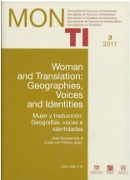Translators vs translatresses’ strategies: ethical and ideological challenges
Contenido principal del artículo
Resumen
Descargas
Detalles del artículo
La propiedad intelectual de los artículos pertenece a los autores y los derechos de edición y publicación, a la revista. Los artículos publicados en la revista podrán ser usados libremente para propósitos educativos y científicos, siempre y cuando se realice una correcta citación del mismo. Cualquier uso comercial queda expresamente penado por la ley.
Citas
PRIMARY SOURCES
Haddon, M. (2003) The Curious Incident of the Dog in the Night-Time. London: Jonathan Cape Ltd. Translated into Galician by Moisés Barcia as O curioso incidente do can á media noite, Rinoceronte Editora, 2008. Translated into Spanish by Patricia Antón as El curioso incidente del perro a medianoche, Barcelona: Ediciones Salamandra, 2004. Translated into Italian by Paola Novarese as Lo strano caso del cane ucciso a mezzanotte, Turin: Einaudi, 2003.
Woolf, V. (1928) Orlando. A Biography. London: Penguin Books, 1993. Translated by Alessandra Scalero as Orlando, Milan: Medusa-Mondadori, 1933; and by Alberto Rossati as Orlando. Un uomo? Una donna?, Milan: Rizzoli, 1993.
SECONDARY SOURCES
Baker, M. (2006) Translation and Conflict. A Narrative Account, London:Routledge.
Braun, F. (1997) “Making men out of people: the MAN principle in translating genderless forms”. In: Kotthoff, H. & R. Wodak (eds.) Communicating Gender in Context. Amsterdam: John Benjamins, pp. 3-30.
Brufau Alvira, N. (2010) “Interviewing Luise von Flotow: A new state of the art”. Quaderns 17. pp. 283-292.
Castro Vázquez, O. (2009) “El género (para) traducido: pugna ideológica en la traducción y paratraducción de O curioso incidente do can á media noite”. Quaderns 16. pp. 251-264.
Chesterman, A. (1997) Memes of Translation. Amsterdam: John Benjamins.
Hönig, H. & P. Kussmaul (1982) Strategie der Übersetzung. Ein Lehr- und Arbeitsbuch. Tübingen: Gunther Narr Verlag.
Guarrido Virlariño, X. M. (2005) “Texto e paratexto. Tradución e paratradución”. Viceversa 9-10. pp. 31-39.
Leonardi, V. (2007) Gender and Ideology in Translation: Do Women and Men Translate Differently? A Contrastive Analysis from Italian into English. Bern: Peter Lang.
Massardier-Kenney, F. (1997) “Towards a Redefinition of Feminist Translation Practice”. The Translator 3(1). pp. 55-69.
Mills, S. (2003) “Third wave linguistic feminism and the analysis of sexism”. Discourse Analysis Online 2:1. http://extra.shu.ac.uk/daol/articles/open/2003/001/mills2003001-paper.html. (Accesed on May 20, 2010)
Mills, S. (2008) Language and Sexism. Cambridge: Cambridge University Press. Reimóndez, M. (2009) “The curious incident of feminist translation in Galicia: court cases, lies and gendern@tions”. Journal of Contemporary Galician Studies, Issue A. pp. 68-89.
The Telegraph, Curious case of the sex changes, 5th April 2008. http://www.telegraph.co.uk/news/worldnews/1584020/Curious-case-of-the-sex-changes.html. (Accessed on June 26, 2010)
Tymoczko, M. (1999) Translation in a Postcolonial Context: Early Irish Literature in English Translation. Manchester: St. Jerome.
Von Flotow, L. (1991) “Feminist translation: Context, practices, theories”. TTR 4(2). pp. 69-84.
Von Flotow, L. (1997) Translation and Gender: Translating in the ‘Era of Feminism’. Manchester: St Jerome.
Von Flotow, L. (1998) “Dis-unity and diversity”. In: Bowker, L.; M. Cronin; D. Kenny & J. Pearson (eds.) 1998. Unity in Diversity? Manchester: St Jerome, pp. 3–13.


